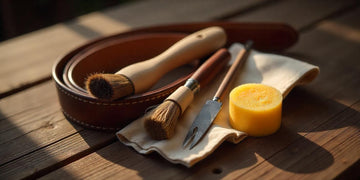Leather jackets are more than just a fashion statement—they're an investment. A well-crafted high-quality leather jacket can last for decades, gaining character and charm over time. But with so many options out there, how can you tell if a jacket is truly premium or just an overpriced knockoff?
This guide will walk you through the essential factors to look for when buying a leather jacket. Whether you're after a rugged biker look or a sleek, modern fit, knowing these details will help you make the right choice.
1. Understanding Leather Quality: Not All Leather is Created Equal
Leather comes in different grades, and choosing the right one makes all the difference in durability, comfort, and aesthetics.
Types of Leather Used in Jackets
|
Leather Type |
Quality Level |
Characteristics |
|
Full-Grain Leather |
Highest |
Thick, durable, develops patina over time |
|
Top-Grain Leather |
High |
Smooth, slightly processed for uniformity |
|
Genuine Leather |
Medium |
Processed, lower durability, often bonded |
|
Bonded Leather |
Low |
Made from leather scraps, wears out quickly |
-
Full-Grain Leather is the best of the best. It retains the natural imperfections and strength of the hide, making it extremely durable. -
Top-Grain Leather is slightly sanded down for a more even texture, still high-quality but slightly less durable.
-
Genuine Leather is misleadingly named—it’s lower-quality leather that’s been heavily processed.
-
Bonded Leather is the lowest grade, often made from leftover scraps glued together.
Real-World Example: A vintage Harley-Davidson leather jacket made from full-grain leather is still in excellent condition after 30 years, whereas a cheap bonded leather jacket may start peeling in less than two years.
2. Leather Thickness & Feel: How to Spot Quality by Touch
A premium leather jacket should feel substantial yet flexible. High-quality leather has a natural texture and softens over time.
How to Test Leather Quality
-
The Pinch Test – High-quality leather has a firm but supple feel when pinched.
-
The Scratch Test – Gently run your fingernail over the surface. Full-grain leather develops minor marks that fade, showing natural aging. Cheap leather often stays untouched or cracks.
-
The Smell Test – A true leather jacket has a rich, earthy smell. Synthetic or low-quality leather has a chemical or plastic-like odor.
Cultural Reference: Think of a high-quality leather jacket like a fine whiskey—it gets better with age, developing unique character over time.
3. Stitching & Construction: The Devil is in the Details
A jacket’s stitching reveals a lot about its quality. Poor stitching means weak seams that will unravel with wear.
What to Look for in Stitching
✅ Even, tight, and reinforced stitching along seams.
✅ Double-stitched or triple-stitched seams for extra durability.
❌ Loose threads or uneven spacing indicate poor craftsmanship.
Comparison Example: A premium brand like Schott NYC ensures every seam is reinforced, while many mass-produced jackets have loose, fraying edges within months.
4. Lining & Interior Fabric: Hidden Signs of Quality
The interior of a leather jacket is just as important as the exterior. A poorly lined jacket can make even the finest leather uncomfortable.
Best Lining Materials
-
Satin or Silk: Luxurious, breathable, and comfortable.
-
Quilted Cotton: Ideal for colder weather, adding warmth.
-
Polyester (Cheap Option): Often used in low-end jackets; less breathable.
Real-World Case Study: A high-end Italian leather jacket with a silk lining remains comfortable for years, whereas cheap jackets with polyester linings start to feel sticky after a few wears.
5. Hardware & Zippers: The Small Details Matter
A premium leather jacket uses high-quality zippers and buttons that don’t break easily.
Signs of Quality Hardware
-
Brass or YKK Zippers: Smooth and durable.
-
Metal Snaps and Buttons: Sturdy and resistant to rust.
-
Poor-Quality Plastic Zippers: Break easily and feel flimsy.
Example: A Schott leather jacket with a heavy-duty YKK zipper can last decades, while a fast-fashion jacket with a plastic zipper can fail within a year.
6. Fit & Style: A Jacket Should Feel Like a Second Skin
A good leather jacket should fit snugly but allow comfortable movement.
How to Ensure the Right Fit
-
Shoulders: Seams should align with your natural shoulder line.
-
Sleeves: Should end at your wrist, not over your hands.
-
Torso: Fitted but with room for layering.
Style Tip: American icons like James Dean and Steve McQueen made leather jackets legendary. A well-fitted jacket can elevate any outfit instantly.
Difference Between High-Quality & Low-Quality Leather Jackets
|
Feature |
High-Quality Jacket |
Low-Quality Jacket |
|
Leather Type |
Full-Grain or Top-Grain |
Bonded or Genuine Leather |
|
Stitching |
Double or Triple-Stitched |
Loose, Uneven Stitches |
|
Lining |
Silk or Quilted Cotton |
Cheap Polyester |
|
Hardware |
YKK Zippers, Brass Buttons |
Plastic Zippers, Flimsy Buttons |
|
Durability |
Lasts 10+ Years |
Wears Out in 1-3 Years |
Conclusion: Investing in a Premium Leather Jacket
A high-quality leather jacket isn’t just about fashion—it’s about craftsmanship, longevity, and timeless style. Whether you’re a biker, a fashion enthusiast, or just looking for a durable staple, knowing what to look for will ensure you get the best value for your money.
Pro Tip: Always buy from reputable brands and check reviews before purchasing. You can explore a wide range of premium leather jackets at
A premium leather jacket is worth the investment, and now you have the knowledge to make the best choice. Whether you’re going for a classic bomber, a rugged biker jacket, or a sleek modern fit, quality always wins.





